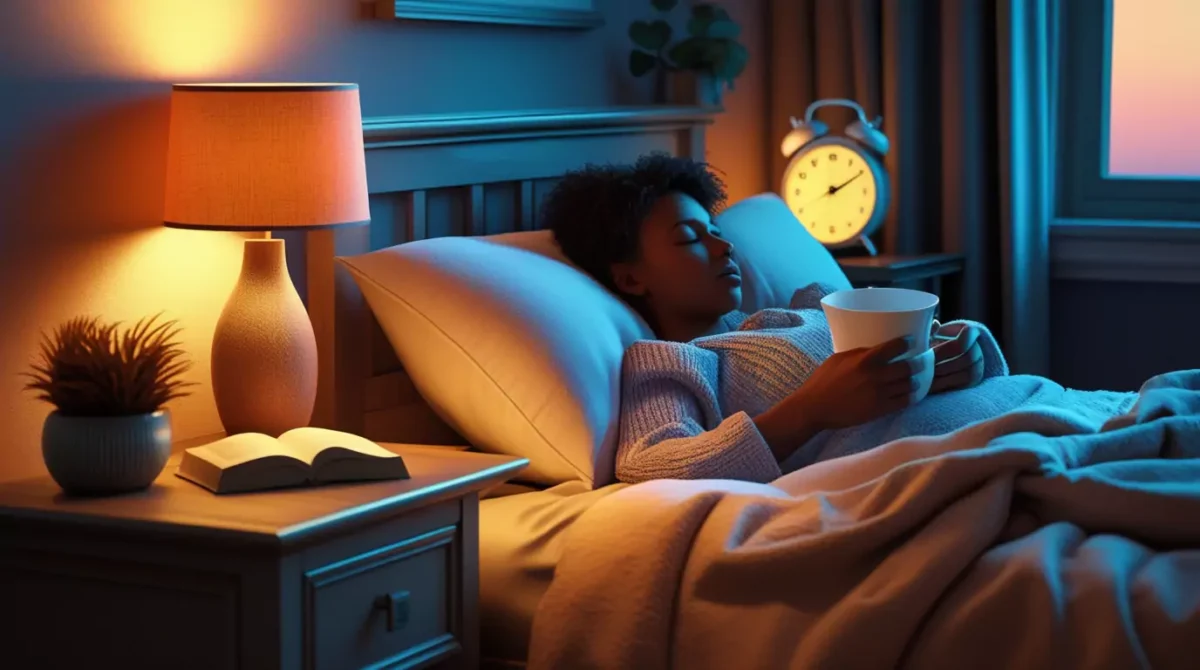You know that feeling when winter hits and suddenly your sleep schedule goes to hell?
Yeah, me too.
Your body clock gets confused when daylight disappears at 4 PM.
And if you’re dealing with seasonal affective disorder (SAD), bedtime becomes this weird battle between being exhausted all day but wide awake at night.
I’ve been there.
The good news? A solid bedtime routine can actually help your brain fight back against winter’s darkness.
Jump to
ToggleWhy Your Sleep Gets Messed Up During Winter Months
Here’s what happens when the seasons change:
Your brain produces melatonin (the sleepy hormone) earlier in the day because it’s darker outside.
So you feel tired at 3 PM but somehow can’t fall asleep at 10 PM.
Your circadian rhythm gets thrown off like a broken clock.
Plus, seasonal depression makes everything harder – including getting quality sleep.
The Science Behind SAD and Sleep Problems
People with seasonal affective disorder often struggle with:
- Hypersomnia – sleeping way too much but still feeling tired
- Delayed sleep phase – can’t fall asleep at normal times
- Fragmented sleep – waking up multiple times during the night
- Early morning awakening – up at 4 AM feeling like garbage
Your brain chemistry literally changes during darker months.
Less sunlight means less serotonin production.
More darkness means more melatonin at weird times.
It’s not in your head – it’s real biology.
Building Your Perfect SAD Bedtime Routine
Start 2-3 Hours Before Bed
7 PM – Begin Your Wind Down
Turn on all the lights in your house.
I’m serious.
Bright light therapy isn’t just for morning – you need light until about 2 hours before sleep.
This helps reset your internal clock.
8 PM – Create Your Environment
- Dim the lights gradually
- Set your bedroom temperature to 65-68°F
- Put your phone in another room (yes, really)
- Start playing white noise or calming music
The Golden Hour Before Sleep
9 PM – Relaxation Rituals
Pick 2-3 activities that work for you:
- Warm bath or shower – raises your body temperature then drops it, making you sleepy
- Reading fiction – not self-help books that make your brain work
- Gentle stretching – nothing intense, just easy movements
- Meditation or breathing exercises – even 5 minutes helps
- Journaling – dump your thoughts on paper so they stop bouncing in your head
9:30 PM – Supplement Strategy
Talk to your doctor about:
- Melatonin (0.5-3mg, 30 minutes before bed)
- Magnesium glycinate (200-400mg)
- Vitamin D3 if you’re deficient
Don’t just pop pills without medical advice.
But these can be game-changers for SAD sleep issues.
What NOT to Do Before Bed
Skip These Sleep Killers:
- Caffeine after 2 PM (yes, even chocolate)
- Big meals within 3 hours of sleep
- Intense exercise within 4 hours
- Blue light from screens (use blue light filters if you must)
- Alcohol (it might make you drowsy but ruins sleep quality)
- Stressing about tomorrow’s to-do list
Morning Habits That Improve Night Sleep
Your bedtime routine actually starts when you wake up:
Get bright light exposure within 30 minutes of waking
This is huge for people with SAD.
Use a 10,000 lux light therapy lamp for 20-30 minutes while having coffee or breakfast.
Keep consistent wake times
Even on weekends.
I know, I know – it sucks.
But your circadian rhythm loves predictability.
Exercise during daylight hours
Even a 10-minute walk outside helps regulate your sleep-wake cycle.
Creating Your Sleep Environment
Bedroom Setup for SAD
Make it cave-like for sleep:
- Blackout curtains or sleep mask
- Cool temperature (your body needs to drop temperature to sleep)
- Comfortable mattress and pillows
- Remove work materials and screens
But prep for morning light:
- Set up your light therapy lamp next to your bed
- Use a sunrise alarm clock that gradually brightens
- Keep curtains easy to open for natural morning light
Sample Bedtime Routine Schedule
7:00 PM – Bright lights on, finish dinner
8:00 PM – Begin dimming lights, start relaxing activities
8:30 PM – No more screens, warm shower/bath
9:00 PM – Reading, stretching, or meditation
9:30 PM – Supplements (if using), final bathroom trip
10:00 PM – In bed, lights out, breathing exercises
10:30 PM – Asleep (hopefully!)
Adjust these times based on your schedule.
The key is consistency, not the exact times.
Troubleshooting Common SAD Sleep Issues
“I’m Exhausted All Day But Can’t Fall Asleep”
Your melatonin timing is probably off.
Try:
- Morning light therapy within 1 hour of waking
- No screens 2 hours before bed
- Melatonin supplementation (with doctor approval)
“I Sleep 10+ Hours But Still Feel Tired”
You might have hypersomnia from SAD.
Focus on:
- Consistent wake times even if you’re tired
- Bright light therapy immediately upon waking
- Limiting daytime naps to 20 minutes max
“I Wake Up Multiple Times During the Night”
Your sleep environment needs work:
- Check room temperature (should be cool)
- Eliminate noise and light sources
- Avoid fluids 2 hours before bed
- Consider magnesium supplementation
When to Seek Professional Help
See a doctor if you have:
- Persistent insomnia lasting more than 2 weeks
- Thoughts of self-harm or severe depression
- Sleep issues that don’t improve with routine changes
- Excessive daytime sleepiness affecting work/relationships
Don’t suffer in silence.
Seasonal affective disorder is a real medical condition that responds to treatment.
FAQs About SAD Bedtime Routines
How long does it take to see results from a new bedtime routine?
Most people notice improvements within 1-2 weeks of consistent practice.
Your circadian rhythm needs time to adjust.
Stick with it even if you don’t see immediate changes.
Should I use melatonin every night for SAD?
Only with medical guidance.
Melatonin can be helpful for resetting your sleep cycle during seasonal changes.
But timing and dosage matter a lot.
Can I exercise at night if it helps my mood?
Light exercise like yoga or stretching is fine.
Avoid intense cardio within 4 hours of bedtime.
It raises your body temperature and heart rate when you need them to drop for sleep.
What if my work schedule doesn’t allow for consistent bedtimes?
Focus on what you can control:
Keep wake times consistent when possible
Use bright light therapy during your “morning” (whenever you wake up)
Create the same pre-sleep routine even if timing varies
Do sleep apps actually help with SAD?
Some can be useful for:
Playing white noise or nature sounds
Guided meditation or breathing exercises
Tracking sleep patterns to identify problems
But avoid apps that require looking at your phone screen before bed.
How important is diet for SAD-related sleep issues?
Pretty important.
Eat regular meals to keep blood sugar stable.
Include foods rich in tryptophan (turkey, eggs, cheese) in your dinner.
Avoid sugar crashes that can mess with sleep hormones.
The Bottom Line
Creating a bedtime routine for seasonal affective disorder treatment isn’t about following every single rule perfectly.
It’s about finding what works for your body and your schedule.
Start with 2-3 changes and build from there.
Your sleep will improve.
Your mood will get better.
And winter won’t feel like such a beast.
The key is consistency and patience with yourself as you figure out what helps your particular flavor of SAD and sleep struggles.






